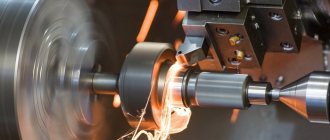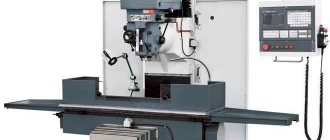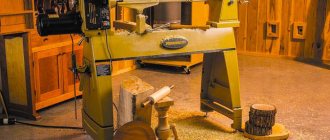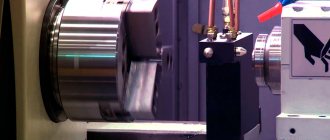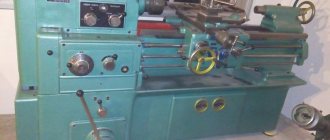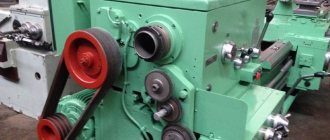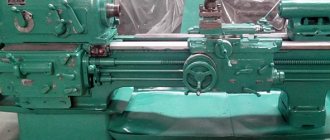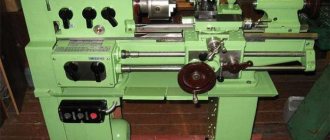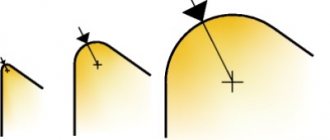People have long realized the possibility of obtaining smooth and even and even standard surfaces by turning the workpiece while rotating it. The appearance of the first lathe dates back to 650 BC.
Its design was ridiculously simple: 2 coaxial centers, between which the workpiece was inserted. One person rotated this workpiece, and another, using a cutter made of a harder material, turned it.
The parts were mainly made of bone or wood, since there was neither sufficient power for processing metal nor materials of sufficient hardness (so that a chisel could be made). Time passed, technology developed, and so gradually, the machines reached their modern appearance and capabilities.
Classification, types
At the present stage, there are several types of lathes, or rather 9 groups of lathe equipment according to various parameters. It seems interesting to consider them in more detail:
Automatic and semi-automatic
Semi-automatic is a type of equipment in which some processes are not automated. For lathes, these are, as a rule, manipulations associated with loading and removing workpieces.
Semi-automatic machines are very common due to their simpler design, as well as low cost. And at enterprises, semi-automatic machines are used to process non-standard, large-sized workpieces, which does not allow the process to be fully automated.
Semi-automatic machines are divided into:
- by purpose - specialized and universal;
- according to the type of workpiece being processed - for cartridge-type machines and for bar-type machines;
- by the number of spindles - single- and multi-spindle;
- by spindle positioning - vertical and horizontal.
Automatic lathes are those in which all main and auxiliary actions are fully automated (including feeding and removing workpieces, as well as changing the processing tool). Automatic lathes are conventionally divided into 3 groups:
Automatic machines with one camshaft, which rotates at one frequency specified for a given mode of processing the part.
- Automatic machines whose camshaft has at least 2 rotation speeds.
- In machines of this type, in addition to the main shaft, there is also an auxiliary shaft, rotating at a significantly higher frequency.
Multi-spindle
Multi-spindle lathes are those with several spindles for fastening both the workpiece and the processing tool. Processing of a part on such a machine can occur both simultaneously (that is, with the participation of all spindles) and sequentially (that is, at the same time with the use of only one spindle).
As a rule, automatic lathes are multi-spindle. Modern turning “multi-machining” centers provide not only spindles with different rotation speeds, but also those adapted for the use of various types of equipment (drills, cutters, cutters). That is, each spindle has its own force threshold.
Revolving
These are universal machines in the modern sense of the word. Various tools are clamped in the tool holders of the turret-shaped head of the machine. These can be cutters, drills or cutters.
The workpiece is clamped in the chuck and processed with one tool for each pass. After each pass, the head rotates (like the drum of a revolver - hence the name) and the workpiece is processed with the next tool.
As you can understand, such machines provide a great advantage, expressed in saving time when changing tools and workpieces. However, the use of such equipment is economically justified only if it is necessary to process various parts on-line.
Cutting group machines
The functionality of the machines becomes clear from the name. These are highly specialized machines that are produced semi-automatically.
The main task of this equipment is to reduce the diameter of the workpiece to the minimum possible, so that in the future it can be cut on another type of equipment (say, on a milling machine). Or, if the format for fastening the workpiece allows, complete its trimming with processing of the end surface.
Carousel models
Rotary-type lathes are designed for processing cylindrical workpieces whose diameter significantly exceeds their height. Rotary machines have the following characteristic features:
- This equipment is designed to work with large parts. Such machines come in single- or double-column types. In the first case, the diameter of the faceplate does not exceed 1600 mm, and in the second – 25000 mm!
- The machine itself (usually semi-automatic) is of a vertical type and has compact dimensions.
- Taking into account the vertical position of the spindle, the load on the shaft is more uniform than in the case of its horizontal positioning, therefore, rotary machines have a significantly longer technical life.
- Modern rotary machines are easy to use. They are often made in a revolving design.
Frontal and screw-cutting equipment
Frontal lathes are not widely used at present. They are mainly found in shipbuilding enterprises, as well as in repair shops. This is a highly specialized type of equipment (intended for processing short workpieces) whose diameter exceeds the length, however, not so much that there is a need to use a carousel type of equipment.
In addition, on frontal lathes there is no tailstock and mainly the end surface of the workpiece is processed (that is, the work is carried out “head-on” - hence the name).
A screw-cutting lathe is equipped with a lead screw, as well as a lead roller, and is designed for cutting threads on a workpiece while the slide moves along the axis of the machine. However, this machine specialization does not impose restrictions on any other types of turning work. However, such machines are used mainly in small-scale production.
Multi-cutting and polishing
A characteristic feature of multi-cutting machines is their high productivity. Several supports are attached to the frame at once, where the cutters are secured (no other tool can be secured here).
The feed mechanisms on each support, which, as a rule, are also equipped with variators for the speed of their movement, ensure processing of a rotating part clamped in the chuck at each (“critical”) section of its length.
As a result, such machines:
- horizontal type;
- designed for processing long workpieces;
- economically feasible for continuous processing of standard parts.
The main characteristic feature of turning and polishing machines is the high rotation speed of the chuck with the workpiece clamped in it. In addition, the transverse stroke of the caliper has a very small thread pitch (to deepen it even by a millimeter, you will need to turn the handle several dozen times).
Such equipment is needed to raise the class of surface finish, and this requires:
- the maximum possible rotation speed of the workpiece being processed;
- minimal braking effect, for which the chips are removed to a minimum thickness.
Modern models of polishing machines use the vibration effect of the cutter.
Specialized
This type of turning equipment is used to produce similar parts. For example: couplings, pipes; This type includes gear-cutting and turning-backing machines. They are most effective in the operation being performed, but, as a rule, only in one of its varieties.
A feature of specialized machines is the emphasis on quick changes of cutting tools and accessories. Such machines are used in large-scale production
Special purpose
Such lathes are designed for the production of parts in non-serial (that is, small) quantities. These machines are characterized by:
- large amplitude of lateral movement of the caliper;
- extended bed (with a horizontal workpiece);
- lower speed, but greater accuracy and purity of processing.
Special purpose machines include:
- screw-cutting lathes (not to be confused with screw-cutting lathes);
- multi-cutting semi-automatic lathes;
- semi-automatic hydrocopiers.
Classification of tabletop turning units
Tabletop lathes have several modifications:
- Revolver. The peculiarity lies in the method of installing the cutter. The entire assembly is placed in a drum. It becomes possible to carry out several types of processing of a part without restructuring the equipment.
- Screw-cutting. Designed to conduct a variety of operations.
- Multi-spindle. Operations are performed with workpieces of different diameters.
- CNC. The computer program is being connected. Without human intervention, the process goes faster and better.
The machine performs operations of varying complexity - rough machining of forgings, forming the desired surface, boring the internal cavity, cutting off the ends.
What accuracy classes exist and how do they differ?
The accuracy class is a generalized characteristic of measuring instruments, which is determined by the limit of errors (main and additional), as well as a number of properties that influence the accuracy of measurements made with their help.
The error limit is the greatest error of the measuring device at which it is suitable for measurement. The limit of permissible basic error is expressed in the form:
- absolute;
- relative;
- given
Errors. The class characterizes the property of accuracy of measurements using this device. And the accuracy of measuring instruments is the quality of a measuring device, which indicates that the error of the measurements is close to zero.
If we are talking about the class of accuracy that is provided, for example, by a lathe, then here we mean the class of surface finish of the part that this equipment is capable of providing during the processing of the workpiece.
Measuring instruments, as well as processing equipment, have the following accuracy classes: 0.01; 0.015; 0.02; 0.025; 0.04; 0.05; 0.1; 0.15; 0.2; 0.25; 0.4; 0.5; 0.6; 1.0; 1.5; 2.0; 2.5; 4.0; 5.0; 6.0. In addition, there are several categories of accuracy classes:
Special
This “Class C” is the highest class of equipment accuracy (both measuring and processing). This class includes machines (in our case, lathes) that must process workpieces to obtain the highest class of surface finish (0.01-0.015).
High
For example, jewelry, medical and laboratory scales have a high level of accuracy. Another name for such equipment is precision. It is marked “class B”. If we are talking about turning equipment, then a high class of cleanliness (0.02-0.025) is provided by polishing lathes.
Normal
The normal accuracy class (the marking is “class H”, but as a rule it is not placed) means such a characteristic of equipment or a part that ensures identical results in no less than 98% of obviously identical objects. The absolute indicator of the normal cleanliness class is in the range (2.0-0.6).
Particularly high
Equipment of a particularly high accuracy class is marked “Class A” for this indicator. When designing high-precision equipment, increased attention is paid to the quality of spindle bearings.
Here, rolling bearings are mainly used, also of high accuracy classes, and sliding bearings are made in the form of adjustable tapered bushings. (All standards here are established by GOST 1969-43).
Increased
This accuracy class is marked “class P”. The use of elements of a higher accuracy class (primarily bearings) increases the cost of the finished product processed on such turning equipment.
However, if it is necessary to obtain a higher class of workpiece processing, then elements of a higher accuracy class are used for positioning machine shafts, where higher accuracy and rotation speed are required.
Exploitation
In order for mini-machines to serve for a long time, they must be properly maintained:
- After finishing work, small chips accumulate on the surface of the machine. It must be deleted.
- Both guides are lubricated with machine oil.
- The oil in the box is changed periodically.
- Electrical wiring and motor are inspected regularly. All accumulated dirt must be removed.
To make a tabletop lathe yourself, you need certain knowledge, as well as the ability to work with metal. If there are difficulties in these matters, there is an alternative solution - purchasing a finished product. This will cost more, but will save time.
Notation systems and decoding, what is it?
There are 2 types of designation systems for metal machines. Let's look at the nomenclature of each of them separately:
Serial production machines.
Let's say we have the designation “16K20F3S5”. Here's what each symbol means:
- 1 – group to which the machine belongs (1 – turning);
- 6 – type of machine (6 – frontal equipment; 5 – rotary; 1 – automatic and semi-automatic);
- K – the presence of the symbol means that the machine is made according to a modernized design;
- 20 – the main operational parameter (it characterizes the height of its centers);
- F3 – type of numerical program control;
- C5 is a type of computing device (CNC).
Special, specialized and precision machines.
Let's say we have the marking “IR500MF4”:
- IR – symbol of the manufacturer;
- 500 is the main operational parameter (characterizes the height of its centers);
- M – type of modification;
- F4 – type of numerical program control.
How to choose an option for your home
A well-chosen home lathe will also be useful when servicing a vehicle and will significantly simplify the tasks of caring for your garden plot.
If you have such equipment, you can always grind any necessary part for repair. To avoid making a mistake when choosing a home machine, consider the following nuances:
- Budget . Often, for home use, purchase a basic model. And various additional functionality is equipped as needed.
- Quality . Before making a purchase, carefully inspect the model for possible damage. And do not make such transactions online (for ordering and delivery). After all, in this case there will be no opportunity to touch, look and check the machine.
- Varieties . The choice of a home lathe depends on the purpose of its further use.
Expert opinion
Levin Dmitry Konstantinovich
If your financial capabilities allow, it is better to buy a universal machine that has a large range of functions.
According to their purpose, all such models are divided into 4 main types:
- Tabletop . They are distinguished by their compact size and low weight. The smallest model will weigh about 10-12 kg. This type of machine is designed for processing small parts and operations: trimming edges, grinding, widening or making new holes, turning parts, threading them, etc.
- Universal . Designed to perform several functions at once. The differences are the increased diameter of the workpiece and the increased distance between the two rotating centers. Universal type machines are easy to maintain and easy to use.
- Lathe-screw . These models are especially popular. After all, with their help you can process almost any product, even weighing 10 tons, and the center distance can vary within 7-8 m.
- School . The simplest devices in terms of functionality that anyone can use. These models are capable of processing almost any part, regardless of shape. With their help you can easily cut threads, make holes and give the object the desired shape. And, if necessary, sharpen, polish or roll up household tools. And by purchasing additional equipment, you can significantly expand the capabilities of the device and make the machine suitable for milling or cutting teeth. Such models are small-sized and compact.
School lathes are capable of working not only on metal. With their help you can easily process wood and plastic.
But remember that machines intended for home use are still not as advanced as professional ones. The main inconvenience is the time that has to be spent on processing. But all shortcomings are covered by the guaranteed high quality of the final result.
What are the types of metal turning equipment, brief description?
The nomenclature of lathes designed for processing metal workpieces is consistent with the general classification of turning equipment presented above. Nevertheless, due to the great importance and demand for high-quality metal processing in the economy, it seems reasonable to consider each type of metal lathe separately.
Revolving
The tool holder here is of the drum type. Each slot can accommodate a different type of cutting tool. Its change occurs by simply turning the drum and the part is processed (without spindle braking) with another tool.
This saves time on tool changing. However, economic efficiency here manifests itself only if similar workpieces are processed on-line.
Carousel
Such machines are used for processing steel parts up to 1.5 m in diameter. In this case, single-column machines are used. This equipment has the following components:
- a vertical bed on a round base, on which the workpiece is fastened;
- a vertical guide for the movement of the caliper (usually a revolving type; most often pentagonal, that is, designed to mount 5 types of processing tools);
- round table and faceplate with 4 independently adjustable cams.
The calipers can move both vertically (along the guide) and transversely, adjusting the depth of processing of the workpiece. Such a machine is equipped with a gearbox to change the rotation speed of the workpiece.
In addition, the speed of movement of the caliper can also be changed (adjusted). To improve the ergonomics of equipment control, this machine is equipped with a pendant push-button station.
Multi-spindle
Such machines are designed for simultaneous or sequential execution of technologically complex operations in a continuous type of production (that is, when similar workpieces are processed on a large scale). The blanks can take the form:
- pipes;
- polyhedral or round rods;
- shaped profile, etc.
Such a machine has high productivity and drive power consumption, and in addition, it is distinguished by its massive design.
Screw-cutting
Screw cutting machines have high rigidity and precision in processing the workpiece. Their bed, as a rule, is monolithic, and the headstock is massive and has increased rigidity (capable of withstanding high pressure).
The spindle of such a machine is mounted on high-precision bearings (class “P”, not lower). The caliper carriage has a more elongated shape (on guides), and the caliper itself has no rotating parts.
The lead screw on a metalworking screw-cutting machine has a large diameter, and in addition, it is mounted on roller bearings. As a result, it is ensured:
- smooth movement of the caliper carriage;
- quite a large force even at low speed of movement of the caliper;
- The skew of the carriage is completely eliminated (due to the location of the lead screw between the guides).
Taken together, these measures make it possible to cut threads according to specified parameters with high accuracy.
Automatic and semi-automatic machines
In modern conditions, more and more metal-working turning equipment is produced in automatic form. This is dictated by the need to increase productivity.
Automatic machining turning centers completely eliminate any actions (manipulations) involving humans (including inserting and removing a workpiece into a chuck, as well as changing the cutting tool).
However, such centers are quite expensive, so in cases where high productivity is not required, semi-automatic machines are used, in which all options are automated, except for positioning and strengthening the workpiece and tool.
Lobototurn
A metal-cutting lathe is designed primarily for processing the end side of a workpiece. It does not have a tailstock and is designed for workpieces whose diameter significantly exceeds their height. Lobe lathes are often equipped with turret supports for the convenience and speed of tool changing.
Milling
We are not talking about milling machines, but about turning and milling machines. The main characteristics of such equipment is the ability to perform both turning operations:
- groove;
- drilling;
- cutting, etc.
So is milling the workpiece:
- formation of profile surfaces;
- cutting straight and curved grooves and grooves;
- more efficient trimming.
Such versatility is achieved thanks to the presence of a milling part with a second spindle. Turning and milling machines are used in watchmaking, tool production and other industries where optimization of the workpiece reinstallation process is required.
Longitudinal turning
A special feature of such machines is that the cutting tool can only perform transverse movement. And the longitudinal movement relative to the support is produced by the workpiece itself, fixed in the spindle.
Rigid attachment of the cutter (that is, precisely in the processing zone) allows for high processing accuracy. In addition, the advantages of this type of lathe are:
- possibility of turning workpieces with complex shapes;
- ability to work with workpieces of small sizes and shapes; high rotation speed (up to 6 thousand revolutions per minute) gives
- the ability to achieve high processing accuracy (up to 0.005 mm).
Tabletop
This type of equipment is intended for small industries (for workshops, for handicraft production). They are characterized by increased precision of workpiece processing and low productivity.
But in a workshop, high quality turning is in demand much more often (and it is more urgent) than the possibility of continuous production is realized.
Such machines, as a rule, have a low cost, compact size, and low noise level. Parts and components for such machines (guides, bearings, etc.) are manufactured with a high level of precision.
Modern CNC
Here we are not even talking about individual machines, but about entire turning machining centers. Equipment with numerical control is capable of performing all possible operations with it in one installation of a workpiece, processing several surfaces at once. The characteristic features of such centers are:
- carrying out processing in a closed chamber, without human participation and control;
- cutting tools are replaced automatically;
- the human factor comes down to the competent development of a virtual drawing - a CAD model of the required part.
And then you just need to place the workpiece in a special box and pick up the finished part.
With continuously variable drive
A continuously variable drive is used to smoothly and non-stop change the rotation speed of a machine spindle or feed mechanism.
A continuously variable drive can be compared to a CVT transmission in a car transmission.
As a result, with the help of smooth control it is possible to obtain the most advantageous (from the point of view of ensuring the quality of processing) processing speeds of the workpiece or movement of the cutting tool in the support.
In addition, the time spent in classic machines on stopping the spindle to change the rotation speed of the chuck is saved. The advantages of such equipment are obvious:
- Durability of the machine drive due to the absence of a gearbox.
- Since there are no whole complicating units, it is very simple to carry out maintenance of such machines.
Pipe cutting
There are pipe cutting machines with one or two chucks for positioning the workpiece being processed (depending on the expected size of the workpiece itself). The main functionality of such machines is:
- processing of pipe ends;
- thread cutting;
- forming locking threads on adapters and drill pipes.
These machines are most in demand in the oil industry for pipe preparation and pipeline repair. In addition, pipe cutting lathes are widely used in mechanical engineering.
Woodworking machines
Modern manufacturers offer a wide selection of woodworking machines. General-purpose installations, special models for the production of similar parts, or specialized devices for certain types of wood processing are produced.
To ensure that the equipment fully meets your expectations after purchase, we suggest using the following tips.
- Optimal power depends on the characteristics of the work and the list of operations that will be performed on the selected machine. Household models are considered to be models with a power of up to 3 kW/h, connected to a 220 V network; industrial models are units with higher productivity, which are also distinguished by a greater depth of cut, planing width, and a wider range of functions.
- The bed should be heavy and rigid (cast iron would be the ideal material for its manufacture).
- It is desirable to have a chuck on the headstock or the ability to install it. In the future, this will make it possible to process workpieces that are secured at only one end.
- The ability to install a drill chuck on the tailstock, which will greatly facilitate the task of sharpening blind holes.
- The presence of a spindle speed controller is a convenient feature that will help improve the quality of many technological operations.
- Universal models are equipped with a saw blade, drill, milling cutter, planing shaft with 3 or 4 knives.
Regardless of the type of lathe chosen, its parameters and technical characteristics, special attention should be paid to the quality of its assembly and the manufacturer’s use of materials that can withstand the planned loads. Universal multifunctional modifications always become the optimal solution: with the help of such a machine it becomes possible to solve almost any problem in metal or wood processing.
Show prices for lathes
Design Features
Regardless of the specialization, automation and purpose of lathes, they all have the same components and elements, which makes their design largely universal, and the components interchangeable:
bed
The most massive part of the machine. It is the basic basis for installing all other components on it. The tasks of the bed include:
- ensuring the rigidity of the entire machine structure as a whole;
- concentrating on yourself and extinguishing all arising vibrations.
The bed, as a rule, is cast from cast iron and made monolithic.
However, there are options for a lightweight frame made of profiled pipes (square section). Such machines are installed on vibration supports.
Apron
This is a carriage that moves along guides (under the influence of a lead screw), on which the caliper is rigidly fixed. In addition to automated movement, the apron can also be equipped with a manual drive.
Headstock
Another name for it is the headstock. This is the part of the machine in which the gearbox is located and where the main shaft with a spindle (hence the name) is attached, in which the workpiece is mounted.
Caliper
This is a structural element of a lathe, located on the apron. On the support, in turn, there are tool holders, where the cutting tool is strengthened. Usually they talk about transverse or longitudinal movement not of the cutter or apron (respectively), but of the support.
Gearbox
Structurally, it is located in the headstock. The front panel has speed switch knobs. If the machine is not equipped with a continuously variable drive, then in order to change the gear (that is, the speed of rotation of the workpiece and the force on the shaft), you must first turn off the machine and wait until the main shaft stops.
Electrical part
This structural element includes a traction motor, as well as other electrical equipment with which the machine is controlled.
Tips for buying a used machine for your home
Buying a used unit allows you to save a lot of money. However, when choosing such a product, you must be very careful not to purchase equipment that has functional problems. Let's look at the basic rules that will help you choose the right device.
When purchasing a mini-machine, it is advisable to inquire about the documentation that comes with it. If the seller does not have all the necessary documents for this equipment, then it is better to refuse to purchase a mini metal lathe. Buying a used device that is capable of processing workpieces with high precision is quite difficult, however, it is possible if desired.
Before purchasing a used mini-machine, it is recommended to check its operation. Moreover, it is necessary to test the functionality of the device in all possible modes. It is also worth paying attention to the backlash of moving parts. Clearances must comply with the technical specifications of the device.
Before purchasing a used machine, make sure that it is in working order and that all components are available, otherwise the operation of such a unit may be unsafe
Main technical characteristics
All lathes of the turning group differ from each other in the following technical parameters:
- maximum spindle speed (the higher it is, the better the quality of surface treatment, the higher the cleanliness class);
- force on the shaft in various gears (this parameter depends on the power of the traction motor, so it is customary to talk about the total power of the machine);
- the maximum diameter of the workpiece being processed (the digital parameter in this case is an indicator of the height of the centers of the machine - the clamping points of the workpiece;
- an indicator of what type of machine it is (screw-cutting, turning-milling, face-to-face, etc.);
- presence and degree of automation (determined by the presence and “advancement” of a numerical control module).
In general, the main technical characteristics of a lathe can be gleaned from the markings on its nameplate (see the section “Notation systems and decoding”).
Marking of lathes
To understand what design features turning units have and what their scope of application is, you should pay attention to the equipment labeling.
It consists of several numbers, each of which has its own meaning:
- the first digit is necessarily 1. It means that this unit belongs to the turning group;
- the second digit of the marking indicates the type of lathe;
- the third and fourth numbers indicate the height of its main centers.
By carefully studying all the features of lathe markings and their classification, you can understand the principle of their operation.
General safety instructions
Let's divide the safety rules into 2 large sections:
What should the machine operator do:
- The operator's clothing must be fastened with all buttons while operating the machine. There should be no loose laces. (Probably everyone remembers the humorous warning poster: “To prevent the shaft from getting twisted, roll up your sleeve...”).
- Before turning on the machine, a technical inspection should be carried out.
- All actions on the machine must be performed only in accordance with the detailed technological process of processing the workpiece.
It is strictly prohibited:
- start work during inspection and adjustment of the machine;
- operate the machine with significantly worn centers; use as little as possible, but a defective cutting tool;
- in the absence of proper qualifications, try to correct problems in the electrical equipment of the machine;
- move away from a working machine or entrust work on it to third (untrained) persons.
